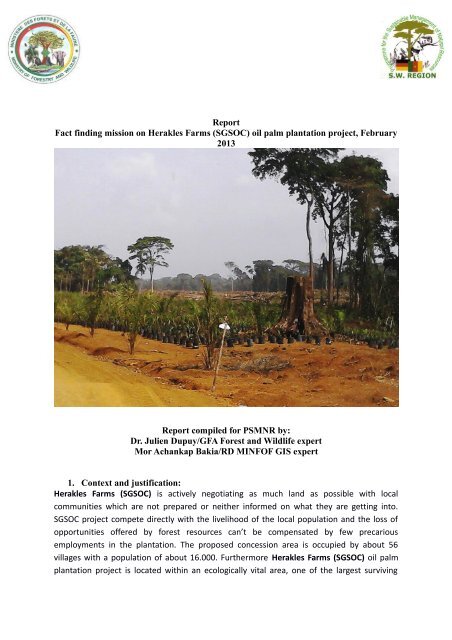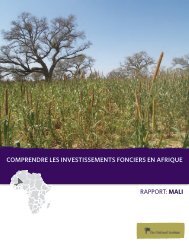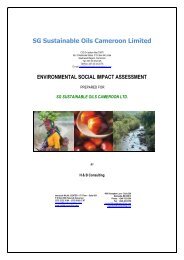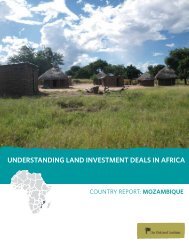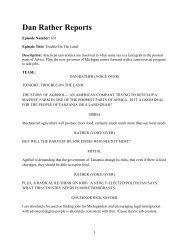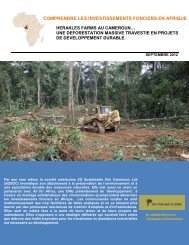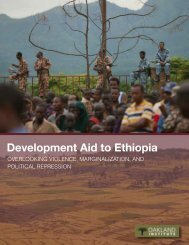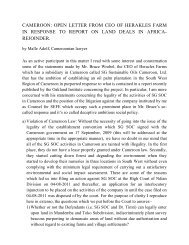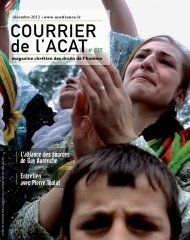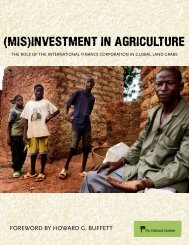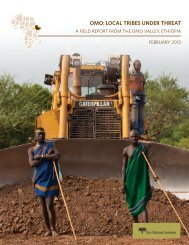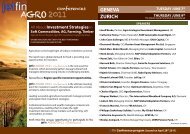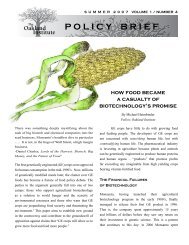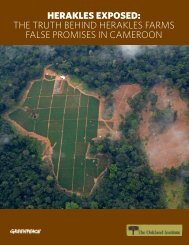Report Fact finding mission on Herakles Farms ... - cameroonveritas
Report Fact finding mission on Herakles Farms ... - cameroonveritas
Report Fact finding mission on Herakles Farms ... - cameroonveritas
Create successful ePaper yourself
Turn your PDF publications into a flip-book with our unique Google optimized e-Paper software.
<str<strong>on</strong>g>Report</str<strong>on</strong>g><str<strong>on</strong>g>Fact</str<strong>on</strong>g> <str<strong>on</strong>g>finding</str<strong>on</strong>g> <str<strong>on</strong>g>missi<strong>on</strong></str<strong>on</strong>g> <strong>on</strong> <strong>Herakles</strong> <strong>Farms</strong> (SGSOC) oil palm plantati<strong>on</strong> project, February2013<str<strong>on</strong>g>Report</str<strong>on</strong>g> compiled for PSMNR by:Dr. Julien Dupuy/GFA Forest and Wildlife expertMor Achankap Bakia/RD MINFOF GIS expert1. C<strong>on</strong>text and justificati<strong>on</strong>:<strong>Herakles</strong> <strong>Farms</strong> (SGSOC) is actively negotiating as much land as possible with localcommunities which are not prepared or neither informed <strong>on</strong> what they are getting into.SGSOC project compete directly with the livelihood of the local populati<strong>on</strong> and the loss ofopportunities offered by forest resources can’t be compensated by few precariousemployments in the plantati<strong>on</strong>. The proposed c<strong>on</strong>cessi<strong>on</strong> area is occupied by about 56villages with a populati<strong>on</strong> of about 16.000. Furthermore <strong>Herakles</strong> <strong>Farms</strong> (SGSOC) oil palmplantati<strong>on</strong> project is located within an ecologically vital area, <strong>on</strong>e of the largest surviving
These sessi<strong>on</strong>s were organized to enable communities to reflect and take a better informeddecisi<strong>on</strong> towards the <strong>Herakles</strong> <strong>Farms</strong> (SGSOC) project and better negotiate with the company.For those who have already entered into the negotiati<strong>on</strong> process, the team providedrecommendati<strong>on</strong>s <strong>on</strong> what bases to re-negotiate the agreement which can better c<strong>on</strong>tribute totheir development and to the c<strong>on</strong>servati<strong>on</strong> of their natural and social envir<strong>on</strong>ment. With theaid of maps the communities were advised to set aside sufficient land for future communitydevelopment and avoid c<strong>on</strong>flict with neighboring communities. Terms of agreementsc<strong>on</strong>tained in the MoUs signed between <strong>Herakles</strong> <strong>Farms</strong> (SGSOC) and the villagers werereviewed with the communities during which they were advised to negotiate meaningfuldevelopment support from the company, in particular the inclusi<strong>on</strong> of small holder schemes.The team has offered PSMNR technical support to realize alternative land use planning andreview their agreements.4. Findings from the <str<strong>on</strong>g>missi<strong>on</strong></str<strong>on</strong>g>:4.1 <strong>Herakles</strong> <strong>Farms</strong> (SGSOC) operati<strong>on</strong>s:In Nguti Sub-Divisi<strong>on</strong>, <strong>Herakles</strong> <strong>Farms</strong> (SGSOC) is currently opening the first 2500 haplantati<strong>on</strong> block negotiated with Talangaye, Ekita, Ebanga and Manyamen. About 600ha ofthis first block already falls outside <strong>Herakles</strong> <strong>Farms</strong> (SGSOC) proposed c<strong>on</strong>cessi<strong>on</strong> limitcovered by their Envir<strong>on</strong>mental Social Impact Assessment (ESIA) (see annex 2, map 1).Neighboring villages such as Badun and New K<strong>on</strong>ye were never c<strong>on</strong>sulted nor associated tothe negotiati<strong>on</strong>s whereas apparently the first block overlaps with their traditi<strong>on</strong>al land. It isworth noticing that these two villages are against <strong>Herakles</strong> <strong>Farms</strong> (SGSOC). The situati<strong>on</strong> isclearly a source of potential c<strong>on</strong>flicts am<strong>on</strong>g the communities c<strong>on</strong>cerned.The result of the inventory recently c<strong>on</strong>ducted by SW MINFOF clearly shows that this firstplantati<strong>on</strong> block is being established within a rich sec<strong>on</strong>dary productive forest. 57 000 m3 ofexploitable timber were inventoried within the 2500ha block which is comparable to thevolume that could be found in any other Forest Management Unit (FMU) exploited in SouthWest Regi<strong>on</strong>. Based <strong>on</strong> our field observati<strong>on</strong>s <strong>Herakles</strong> <strong>Farms</strong> (SGSOC) has open around300ha which is far above the 60ha tolerated by the law if no presidential land lease decree hasbeen signed. <strong>Herakles</strong> <strong>Farms</strong> (SGSOC) has already planted a porti<strong>on</strong> of the land and piles oftimber are waiting to be aucti<strong>on</strong>ed (see also annex 3, picture 1).
Picture 1: Talangaye c<strong>on</strong>cessi<strong>on</strong> block<strong>Herakles</strong> <strong>Farms</strong> (SGSOC) has also opened a 50 meters wide road between Talangaye andSambaliba whereas they had received an authorizati<strong>on</strong> for 15 meters (see annex 3, picture 2).An inventory has been c<strong>on</strong>ducted by SW MINFOF for the planned nursery site in Sambaliba.This inventory has identified even more exploitable timber than in the first block with 11 000m3 inventoried <strong>on</strong> 225 ha.Fabe nursery has been opened in an area of less than 10 ha although 45ha was allocated forthe nursery. The team was denied access to the nursery site despite explanati<strong>on</strong>s from theforestry officials. Nevertheless, the MINFOF staff of the team made their way into thenursery. The seedlings in the Fabe nursery are ready for transplanting, which means thecompany is targeting the Ngumu-Mos<strong>on</strong>gisele area. It is worth noting here that most of thetimber evacuated from the Fabe nursery site was used by the company or allowed todecompose. Some serious evidence of illegal timber exploitati<strong>on</strong> has been noticed close toFabe village with tracks opened by a caterpillar (see annex 3, picture 3 /GPS reading: 495697,559880). There are also very active lands clearing in the area with huge porti<strong>on</strong> of landopened with chainsaws (GPS reading: 495297, 560030). This may be a sign of landspeculati<strong>on</strong> starting in the area.Picture 2:landspeculati<strong>on</strong> around Fabe<strong>Herakles</strong> <strong>Farms</strong> (SGSOC) is not respecting anymore the initial proposed c<strong>on</strong>cessi<strong>on</strong> boundaryand negotiates land far outside the so called “Kupe and Ndian blocks” in areas which are notcovered by their ESIA (see annex 2, map 2). <strong>Herakles</strong> <strong>Farms</strong> (SGSOC) is also currentlynegotiating huge amount of land completely outside their planned c<strong>on</strong>cessi<strong>on</strong> around thevillages of Mos<strong>on</strong>gisele, Weke, Idibanyanga and Ngumu. A total of 11’000ha has beennegotiated with these villages located just at the periphery of the Korup Nati<strong>on</strong>al Park.
and will leave nothing to their communities (forest resources such as timber, wildlife,NTFP…). During their first c<strong>on</strong>tact with the company, <strong>Herakles</strong> <strong>Farms</strong> (SGSOC) wasproposing the development of out-grower schemes. Later <strong>on</strong> the company has progressivelyaband<strong>on</strong>ed this opti<strong>on</strong> and <strong>Herakles</strong> <strong>Farms</strong> (SGSOC) interest is now clearly to get as much landas they can from them. There are other companies such as CDC which propose out-growerscheme for rubber. They have also heard about government programs and grants to supportfarmers with plantain seedlings, cocoa livelihood Program… They proposed that the GoC andinternati<strong>on</strong>al agencies should support technically and financially their local development.The team has collected during its fact <str<strong>on</strong>g>finding</str<strong>on</strong>g> <str<strong>on</strong>g>missi<strong>on</strong></str<strong>on</strong>g> in 20 villages a lot of informati<strong>on</strong>showing the way SGSOC is operating. The negotiati<strong>on</strong> is d<strong>on</strong>e with lot of intimidati<strong>on</strong> andbribery, targeting the chiefs and some few influential decisi<strong>on</strong> - making members of thecommunities (see annex 3, picture 4). The negotiati<strong>on</strong> is not transparent and also differs from<strong>on</strong>e village to another. SGSOC negotiati<strong>on</strong> methods are clearly not respecting “Free Prior andInformed C<strong>on</strong>sent” process (FPIC) principles. “FPIC implies that communities have the rightto decide whether they will agree to the project or not <strong>on</strong>ce they have a full and accurateunderstanding of the implicati<strong>on</strong>s of the project <strong>on</strong> them and their customaryland 4 ”.Communities should be informed <strong>on</strong> what is a large scale plantati<strong>on</strong>, <strong>on</strong> the positiveand negative impacts of <strong>Herakles</strong> <strong>Farms</strong> (SGSOC) project in the short, medium and l<strong>on</strong>g term.Communities should also be made aware of other development models and <strong>on</strong> thec<strong>on</strong>tributi<strong>on</strong> of the forest to their livelihood.<strong>Herakles</strong> <strong>Farms</strong> (SGSOC) land negotiati<strong>on</strong> process principally follows three steps: Producti<strong>on</strong> of a participatory sketch map of the area to be negotiated for showingsacred sites, farmlands, settlement, protected areas, and communal land identified as“unused land” <strong>on</strong> the maps Field surveys to geo-reference land use type and Hold negotiati<strong>on</strong> sessi<strong>on</strong>s with the villages and the signing of MoUsDuring the negotiati<strong>on</strong> sessi<strong>on</strong>s the Communities are c<strong>on</strong>vinced to c<strong>on</strong>cede as much land aspossible without taking into account their own future development needs. The agreed mapsshowing the surface area c<strong>on</strong>ceded are then signed by the village Chiefs <strong>on</strong> behalf of thetraditi<strong>on</strong>al council and later <strong>on</strong> by local government officials. The Communities are obviouslyneither prepared nor equipped for such technical negotiati<strong>on</strong>s with <strong>Herakles</strong> <strong>Farms</strong> (SGSOC)experts since they d<strong>on</strong>’t master land use mapping and land negotiati<strong>on</strong> processes. Some chiefshave declared that they did not realize what they were getting into and are now trying to renegotiatewith SGSOC.To further illustrate the naiveties of the communities in the negotiating process the terms usedin the MoU are very vague and sometime elusive which does not compel the company toanything c<strong>on</strong>crete in particular for instance: Small holder schemes: “SGSOC will leave out land for local out grower schemes forthe cultivati<strong>on</strong> of oil palm and purchase the resulting FFB, thereby providing a creditworthyreliable buyer for local farmers’ producti<strong>on</strong>” (no menti<strong>on</strong> of reference tosurface area, schedule, finance and technical support…).“SGSOC will produce electricity and where practicable will make surplus availableto the communities at low cost”. “SGSOC will create l<strong>on</strong>g term employment” (for whom, how many, whatqualificati<strong>on</strong>?).4 See Forest People Program definiti<strong>on</strong> : http://www.forestpeoples.org/guiding-principles/free-prior-andinformed-c<strong>on</strong>sent-fpic
In fact what has been negotiated locally by the company is sensibly the same for every village(two classrooms, community hall, roads and water). What the company is offering issomehow a prerequisite to their implantati<strong>on</strong> in the area. They will need anyhow road todevelop their plantati<strong>on</strong>, electricity and water for their producti<strong>on</strong>, classrooms to maintainworkers <strong>on</strong> the site. The MoU menti<strong>on</strong>s that:”SGSOC will c<strong>on</strong>tribute a m<strong>on</strong>thly stipend of50.000 FCFA per m<strong>on</strong>th beginning from the first year of operati<strong>on</strong> and 200.000 FCFA perm<strong>on</strong>th from the start of producti<strong>on</strong>”. These already vary from <strong>on</strong>e village to another. Somevillages have obtained 200.000 FCFA for the chiefdom and 400.000 FCFA for the village perm<strong>on</strong>th.What <strong>Herakles</strong> <strong>Farms</strong> (SGSOC) has already negotiated with regards to what the company willgenerate as revenue is ridiculously low. A well-managed plantati<strong>on</strong> can generate 30 t<strong>on</strong>s FFBper ha and therefore 1000ha can generate 30.000 t<strong>on</strong>s (Pers<strong>on</strong>al interview with <strong>Herakles</strong><strong>Farms</strong> (SGSOC) expert from Malaysia). At 50 FRS CFA per kilogram of FFB, 1000ha willgenerate 1.5 billi<strong>on</strong> per year. At 25% extracti<strong>on</strong> rate, 1000ha will produce 7.500 t<strong>on</strong>s of oil.With the current government imposed price of 500 FRS CFA per kg of oil palm, this means1000ha will produce 3.75 billi<strong>on</strong> FRS CFA. The company gives less than 3 milli<strong>on</strong> FCFA peryear to communities’ which are ceding thousands of hectares of land. This amount is notsufficient to impulse local development and will certainly not compensate all opportunitieslost from the suppressi<strong>on</strong> of the forest resources (NTFP, timber, water, soil fertility…).Looking at the amount of land c<strong>on</strong>cerned, most of the villages would obtain more m<strong>on</strong>eyswith REDD+ than what they have been negotiated with the company. While with REDD+,those villages would still enjoy their customary rights and would still benefit from theenvir<strong>on</strong>mental services provided by the forest.A company should not be allowed to prospect for land at will and enters into negotiati<strong>on</strong> withcommunities without c<strong>on</strong>sulting local administrati<strong>on</strong>s. Councils should be c<strong>on</strong>sulted <strong>on</strong> theirdevelopment plans. It is also not normal that a company identifies land village by villagewithout identifying and establishing corridors between Protected Areas. High C<strong>on</strong>servati<strong>on</strong>Value (HCV) areas should not be delineated without first assessing rigorously and at a properscale what will be the envir<strong>on</strong>mental impact of the company interventi<strong>on</strong>. Companies such asCDC, PAMOL and <strong>Herakles</strong> <strong>Farms</strong> (SGSOC) are now competing to obtain as much as land aspossible in the same area. In parallel, a lot of land speculati<strong>on</strong> is occurring at diverse scale.5. Recommendati<strong>on</strong>s:5.1 Land negotiati<strong>on</strong>s with communities:PSMNR str<strong>on</strong>gly advised that <strong>Herakles</strong> <strong>Farms</strong> (SGSOC) land negotiati<strong>on</strong>s should be stopped inparticular outside the proposed <strong>Herakles</strong> <strong>Farms</strong> (SGSOC) c<strong>on</strong>cessi<strong>on</strong> to avoid potential landuse c<strong>on</strong>flicts. Land negotiati<strong>on</strong> should start <strong>on</strong>ce communities have been prepared andproperly informed. To be fair and transparent land negotiati<strong>on</strong>s cannot be left <strong>on</strong>ly in the handof the company. To take a sound decisi<strong>on</strong>, communities should be accompanied by anindependent organizati<strong>on</strong>/mediator to have a reflecti<strong>on</strong> <strong>on</strong> the way they are currently usingtheir land and how they want to develop it.Another challenge is to ensure that the negotiati<strong>on</strong> process and decisi<strong>on</strong>-making are made inways that are inclusive of, and accountable to, members of their communities. We str<strong>on</strong>glyadvise that each village create a land allocati<strong>on</strong> committee composed of the traditi<strong>on</strong>alcouncil, women and youth representatives and some elites. They should be given sufficienttime to reflect <strong>on</strong> their customary land and not push into fast negotiati<strong>on</strong> with crakes of beers,whisky, bags of rice and cows. This land allocati<strong>on</strong> committee should be sensitized andtrained <strong>on</strong> land use planning and negotiati<strong>on</strong>. PSMNR should c<strong>on</strong>tribute to reinforce thefuture visi<strong>on</strong> building of the villages and sensitize them <strong>on</strong> alternative development scenarios
(small holder schemes, NTFP marketing, community forests, REDD…). It is <strong>on</strong>ly after havingsuch reflecti<strong>on</strong> that a community should enter into negotiati<strong>on</strong> with <strong>Herakles</strong> <strong>Farms</strong> (SGSOC).5.2 Review of <strong>Herakles</strong> <strong>Farms</strong> (SGSOC) agreements with local communities:Each agreement should be analyzed by a land c<strong>on</strong>sultative board composed of governmentofficials, chief and notables from the village and civil society. The c<strong>on</strong>sultative board shouldensure <strong>on</strong> the fairness and transparency of the negotiati<strong>on</strong> process. The board should carefullyreview all the negotiati<strong>on</strong> steps, land use maps, ESIA and local participatory impactassessments and benefit-sharing agreements, in particular clear c<strong>on</strong>diti<strong>on</strong>s for thedevelopment of smallholder schemes (> 30 % of the area attributed to <strong>Herakles</strong> <strong>Farms</strong>(SGSOC), technical and financial terms).PSMNR should assist in the creati<strong>on</strong> of such board and assist the community in developing awin-win agreement with the company and in particular in negotiating small holder schemesc<strong>on</strong>tracts. PSMNR should also provide legal advice to the community regarding theircustomary land rights, compensati<strong>on</strong> mechanisms and obligati<strong>on</strong>s of the company.Communities should not be bound for 99 years to this kind of MoU and agreements. Theyshould have the possibility to review and updated and binding documents with the companyperiodically.5.3 Land use planning:The absence of proper land use planning at Council or Divisi<strong>on</strong>al level is the major cause ofthe situati<strong>on</strong> faced by the communities living in Ndian and KupeMuanemguba Divisi<strong>on</strong>s. Thisvacuum is a source of c<strong>on</strong>flicts between communities, an obstacle to local development and athreat to the integrity of protected areas. After the elaborati<strong>on</strong> of their development plans,Councils should be assisted to spatially defined management sectors in accordance with landsuitability, populati<strong>on</strong> needs, development priorities and c<strong>on</strong>servati<strong>on</strong> objectives. Therealizati<strong>on</strong> of such land use plan should assist government officials to better coordinate worksof government agencies and c<strong>on</strong>tribute in resolving c<strong>on</strong>flict between competing land uses.The Law “N° 2011/008 of 6 th May 2011 to lay down guidelines for territorial planning andsustainable development in Camero<strong>on</strong>” give some provisi<strong>on</strong> for the realizati<strong>on</strong> of land useplans at Council level.PSMNR propose to use the TOU (all relevant sector administrati<strong>on</strong>s are represented) to assistin close collaborati<strong>on</strong> with PNDP in the realizati<strong>on</strong> of land suitability analysis and land useplan at Council level which identifies management sectors and define management standards 5 .The Council should be able to plan future agro-industrial development with limited impact <strong>on</strong>other land uses. This land use plan should c<strong>on</strong>cerns am<strong>on</strong>g others: potential wildlife corridorsto be protected, land for settlement and farming expansi<strong>on</strong>, small holder schemes and agroindustry,Community forest...etc. It is also at this scale that should be planned buffers betweenvillages to avoid unnecessary boundary c<strong>on</strong>flicts. A buffer of 3km should be left for comm<strong>on</strong>use. A simple management plan and bylaws could be established between communities toprotect or develop such areas.After having established land use plan at Council level, PSMNR should support negotiati<strong>on</strong> oflocal land use plans at village level. Those local land use plan should fit into the managementstandards defined within the Council land use plan. After defining land units (settlement,5As the land use planning process engaged by MINEPAT is still not engaged <strong>on</strong> nati<strong>on</strong>al, regi<strong>on</strong>al and councillevel and the time is pressing. TOU could develop such a plan at council level together with PNDP as a pilotscheme .Experiences and results could feed the process to be engaged by MINEPAT.
farmland, communal land, important NTFP gathering areas, cultural sites…), the local landallocati<strong>on</strong> committee assisted by PSMNR technical expertise should define local managementsectors, where they could accommodate community expansi<strong>on</strong>, local c<strong>on</strong>servati<strong>on</strong> and landfor agro-industry development. The local land use plan should present operati<strong>on</strong>al issues suchas the c<strong>on</strong>diti<strong>on</strong> to access land for small holders, the c<strong>on</strong>diti<strong>on</strong> to lease land for privatecompanies and the management of communal lands. The proporti<strong>on</strong> of land allocated forprivate companies should not exceed <strong>on</strong>e third of the communal land surface area to avoid thesituati<strong>on</strong> described above where all the most suitable land is given to a company withouttaking into account basic community needs (access to water, forest resources, land…) 6 .5.4 Alternative development opti<strong>on</strong>s:PSMNR should assist in the implementati<strong>on</strong> of the local land use plan in particular foridentified alternatives development measures such as green Income Generating Activities(IGAs such as NTFP marketing, Cocoa farm improvement, cassava, plantain development…)and out grower schemes for rubber or oil palm (with <strong>Herakles</strong> <strong>Farms</strong> (SGSOC) and/or othercompanies). PSMNR should liaise with MINADER and PNDP to obtain informati<strong>on</strong> <strong>on</strong> ruraldevelopment initiatives/plans for South West Regi<strong>on</strong>.Another way to secure community land rights effectively and generate incomes would be todevelop community forest network around PAs and al<strong>on</strong>g corridors. Since this process isrelatively short in time it could be an opti<strong>on</strong> to limit <strong>Herakles</strong> <strong>Farms</strong> (SGSOC) project impact<strong>on</strong> the buffer z<strong>on</strong>e and corridors. PSMNR should assess the possibility to obtain REDD+project which would c<strong>on</strong>tribute to finance alternative scenarios. With exploitati<strong>on</strong> inventorydata c<strong>on</strong>solidated with knowledge or the area it would be possible to make some estimati<strong>on</strong>of carb<strong>on</strong> credit to avoided e<str<strong>on</strong>g>missi<strong>on</strong></str<strong>on</strong>g>s and design a Project Intenti<strong>on</strong> Note.6. C<strong>on</strong>clusi<strong>on</strong>:<strong>Herakles</strong> <strong>Farms</strong> (SGSOC) oil palm plantati<strong>on</strong> project as it is planned so far will havec<strong>on</strong>siderable negative impact <strong>on</strong> c<strong>on</strong>servati<strong>on</strong> and <strong>on</strong> peoples’ livelihood in the area of Korup-Nd<strong>on</strong>gere TOU and adjacent areas of Kupe-Manenguba. It is recommended to the c<strong>on</strong>cernedgovernment structures to stop the actual land acquisiti<strong>on</strong> process of <strong>Herakles</strong> <strong>Farms</strong> (SGSOC)and first to review the whole process of land acquisiti<strong>on</strong> in order to come up with clearprocedures which ensure FPIC principles by involving a professi<strong>on</strong>al independentorganizati<strong>on</strong> to mediate the process. Guiding government strategic opti<strong>on</strong>s are listed in thelaw 2011/008 <strong>on</strong> territorial planning and sustainable development and are between others: Improvement of key c<strong>on</strong>diti<strong>on</strong>s in rural areas and optimizati<strong>on</strong> of land use Envir<strong>on</strong>mental protecti<strong>on</strong> Support to some specific areas, namely ecologically sensitive areas Promoting and sustaining food security Development of employment and ec<strong>on</strong>omic growth6 From what we investigated, SGSOC has obtained from 2/3 to 90% of the communal lands (called unused landby SGSOC) of the villages whom entered into negotiati<strong>on</strong> with the company.
<strong>Herakles</strong> <strong>Farms</strong> (SGSOC) shall be attributed a very limited surface area of land right now(
Traditi<strong>on</strong>al Council MemberVillagerepresentativesElitesToko Sub-Divisi<strong>on</strong>Villages ParticipantsNdoiChiefTraditi<strong>on</strong>al Council MemberVillage representativesItaliChiefTraditi<strong>on</strong>al Council MemberVillage representativesIkotiTraditi<strong>on</strong>al Council MemberVillage representativesElitesChiefDiengeTraditi<strong>on</strong>al Council MemberVillage representativesElitesChiefBobangi Traditi<strong>on</strong>al Council MemberVillage representativesElitesChiefMalomba Traditi<strong>on</strong>al Council MemberVillage representativesElitesChiefMundembaSub-Divisi<strong>on</strong>ParticipantMokango ChiefTraditi<strong>on</strong>al Council MemberVillage representativesFabeChiefMeangwe ChiefTraditi<strong>on</strong>al Council MemberVillage representativesNdibaChiefTraditi<strong>on</strong>al Council MemberWomenrepresentativeYouthrepresentativeMos<strong>on</strong>giseli ChiefTraditi<strong>on</strong>al Council MemberVillage representativesIdebeyanga ChiefTraditi<strong>on</strong>al Council MemberVillage representativesNgumuChiefTraditi<strong>on</strong>al Council MemberVillage representatives
WeteChiefTraditi<strong>on</strong>al Council MemberVillage representativesAnnex 2:Map 1 : First exploitati<strong>on</strong> block
Map 2 : New SGSOC developments outside proposed Ndian c<strong>on</strong>cessi<strong>on</strong> blockMap 3: SGSOC sketch map identifying land units and in particular “unused land”Map4:Signed map of Idebayanga and Mos<strong>on</strong>giseli and Weke c<strong>on</strong>cessi<strong>on</strong> block, most of communityland obtained by <strong>Herakles</strong> <strong>Farms</strong> (SGSOC). Community remain <strong>on</strong>ly with KNP buffer z<strong>on</strong>e.
Map 5: Overlap of <strong>Herakles</strong> <strong>Farms</strong> (SGSOC) c<strong>on</strong>cessi<strong>on</strong> with KNP buffer Z<strong>on</strong>e
Map 6: Sambaliba project area covers most of the community land. <strong>Herakles</strong> <strong>Farms</strong> (SGSOC)first obtained 350 ha and finally imposed <strong>on</strong> the community 905 ha, living 639 ha ascommunity land and 263 ha of marginal land. No land is set aside for out grower schemes forcommunities.Annex 3: Pictures
Picture 1: Talangaye c<strong>on</strong>cessi<strong>on</strong> blockPicture 2: Sambaliba road.
Picture 3: illegal logging at the vicinity of FabePicture 4: Mokango community gathered around food and beer provided by <strong>Herakles</strong> <strong>Farms</strong>(SGSOC) to settle land negotiati<strong>on</strong>


